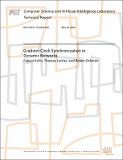Gradient Clock Synchronization in Dynamic Networks
Author(s)
Locher, Thomas; Kuhn, Fabian; Oshman, Rotem
DownloadMIT-CSAIL-TR-2009-022.pdf (396.8Kb)
Additional downloads
Other Contributors
Theory of Computation
Advisor
Nancy Lynch
Metadata
Show full item recordAbstract
Over the last years, large-scale decentralized computer networks such as peer-to-peer and mobile ad hoc networks have become increasingly prevalent. The topologies of many of these networks are often highly dynamic. This is especially true for ad hoc networks formed by mobile wireless devices. In this paper, we study the fundamental problem of clock synchronization in dynamic networks. We show that there is an inherent trade-off between the skew S guaranteed along sufficiently old links and the time needed to guarantee a small skew along new links. For any sufficiently large initial skew on a new link, there are executions in which the time required to reduce the skew on the link to O(S) is at least Omega(n/S). We show that this bound is tight for moderately small values of S. Assuming a fixed set of n nodes and an arbitrary pattern of edge insertions and removals, a weak dynamic connectivity requirement suffices to prove the following results. We present an algorithm that always maintains a skew of O(n) between any two nodes in the network. For a parameter S = Omega(sqrt{rho n}), where rho is the maximum hardware clock drift, it is further guaranteed that if a communication link between two nodes u, v persists in the network for at least Omega(n/S) time, the clock skew between u and v is reduced to no more than O(S).
Date issued
2009-05-29Series/Report no.
MIT-CSAIL-TR-2009-022
Keywords
time synchronization, distributed algorithms, lower bound